Brazil Naturals: Tradition and Innovation
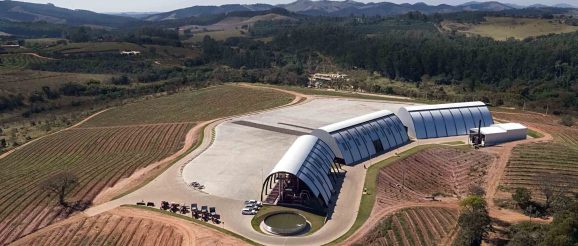
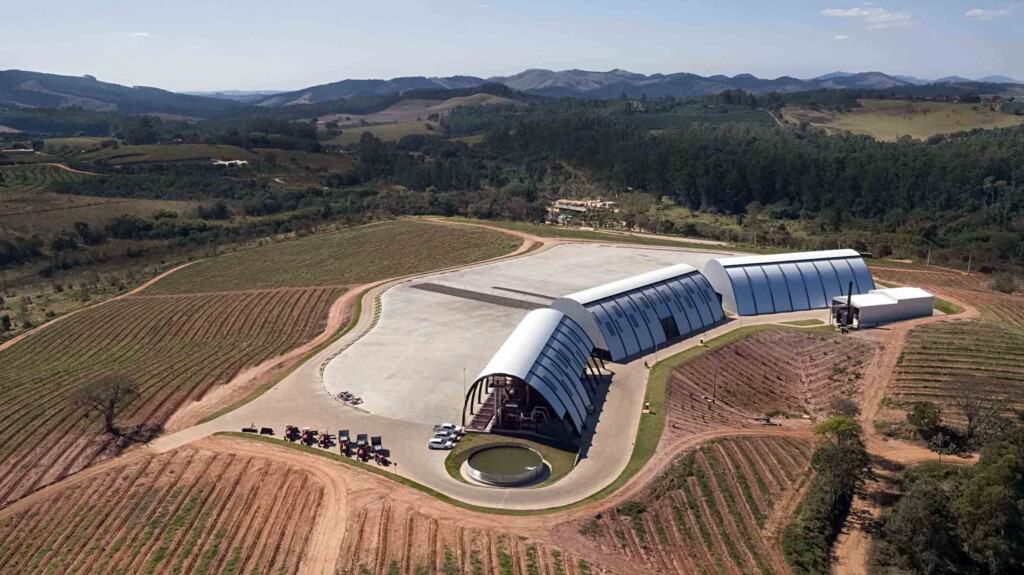
Mill devoted to smaller-lot specialty coffees at Ipanema Farms in the Sul de Minas growing region, Brazil. Courtesy of Ipanema Farms.
When I first opened a specialty café in Berkeley, California 40 years ago, a Brazil always appeared among the standard whole-bean coffee offerings in the 10 or so glass-fronted bins that held our whole-bean coffees. All of the popular and glamorous coffee origins of the time were there: Guatemala Antigua, Kenya AA, Costa Rica Tarrazu, Sumatra Mandheling, Colombia Supremo, and the new, game-changing Ethiopia Yirgacheffe. Brazil Santos, as we liked to call it (all of these origins had to sport at least one secondary qualifying name), was usually down at the end of the row, largely looked past when customers ordered a pound of Kenya or Guatemala.
But some customers did buy Brazils. I remember one particularly coffee-savvy young employee who skillfully worked our Gaggia two-group piston espresso machine, declaring, a little defensively, that Brazil was his favorite origin. He said he liked its low-key balance and its nut, spice and chocolate notes. He found the other more glamorous origins we carried too bright, too one-sided, too insistent.
But there were only a few like him back then, and today, it looks like there are even fewer. In fact, it appears, from this month’s low turnout of Brazil submissions from North American specialty roasters, that Brazil, by far the world’s largest producer of coffee, is one of the tiniest when it comes to upmarket specialty lists of American roasters.
We received only around 30 samples for this report, as opposed to the 60 or more we usually receive for surveys of other origins. But the real shock was the low turnout from North American roasters. Only seven American-roasted Brazil samples showed up! The other 24 were roasted by Asian companies, all based in Taiwan.
Don’t blame the coffees themselves. The 30 samples we tested averaged around 89 on the Coffee Review scale, an excellent showing. And we ran into no coffees at all displaying composty flavors or medicinal hints, for example, two failings of poorer quality coffees everywhere. These were mostly solid, drinkable coffees whose main failing was simplicity or a kind of aromatic laziness.
But if we move from the also-rans to the very best of this month’s Brazils, we encounter some very, very fine samples. Before discussing how and why they are exceptional, I need to back into a brief account of the history and character of the classic Brazil cup.
The Backbone of Specialty: Brazil Naturals
This cup is seldom bright or acidy — credit moderate-to-low growing elevations. It is usually produced from quite respected tree varieties, with pleasing balance and subtle fruit, but without the aromatic fireworks of Ethiopia-derived material like Geisha/Gesha, for example. It is natural-processed, meaning the coffee fruit is simply picked (often by machine) then spread to dry on patios.
The typical outcome is a coffee with pleasing mouthfeel, a structure usually round and low in acidity, with fruit leaning toward chocolate and nut rather than citrus and flowers.
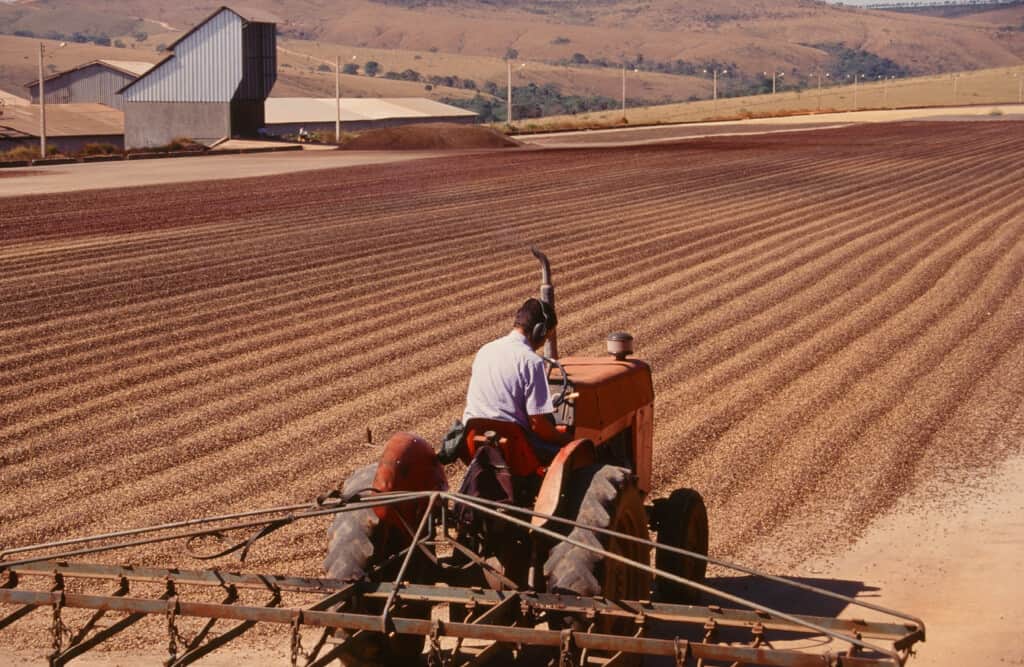
Raking pulped-natural process coffee in the Cerrado Miniero region of Brazil. Courtesy of Kenneth Davids.
None of that sounds particularly exciting, does it? This relatively drab story and satisfying but low-drama cup are probably the reasons why so few roasters sent us Brazil samples. They don’t look for great Brazils, so, presumably, they don’t find them, and if they don’t find them, then their customers won’t, either. The roasters look for Brazils to fill out the middle of blends and harmonize more assertive coffees, not something to stand by itself making its own case. “I think U.S. roasters overlook Brazils far too easily when looking for something ‘unique’ and ‘exciting,’ something to ‘push the industry forward,’” says David Pittman of Peach Coffee Roasters.
Pushing (Or at Least Nudging) the Industry Forward
But some Brazil producers are aiming to “push the industry forward,” as it turns out. And some roasters have begun to take them up on it. Of the eight top-rated coffees that fill out this month’s reviews, five play subtle but decisive variations on Brazil natural processing that expand the style in ways both distinctive and delicious. Two others among the eight represent Brazil’s special gift to processing method, the pulped natural. Only one embodies the tradition of the classic Brazil natural, although it embodies it particularly well.
In the natural process, of course, the beans or seeds remain encased inside the entire fruit all the way from picking to drying. However, with five of the samples we tested for this report, the whole fruit was subject to an unorthodox fermentation step before being spread to dry.
Whole-Fruit Fermentation as Sensory Game-Changer
Fermentation, of course, has long been a key step in traditional wet-processing, where it is used to soften sticky fruit flesh so it can be more easily “washed” off the beans. But with this month’s unorthodox Brazils, fermentation was applied to the coffee in the whole fruit as a clear attempt to enhance final cup character and originality, rather than simply facilitate a mechanical process.
I’m thinking that a plausible name for this processing variation might be “enhanced natural.” Among other benefits, the fermentation step may slow down drying, thereby intensifying the development of fruit and sweetness and avoiding the too-rapid drying of the fruit that, in traditional natural Brazils, may turn fruit notes prune-like and promote a dry, woody cup.
The exact nature of the fermentation step varies in all five of these “enhanced naturals.” In the case of the top-rated Kakalove Café Fazenda Samambaia Natural Fermentation Arara (95), the fruit was fermented in (apparently open-topped) barrels for four days before the usual drying on raised beds. This ferment was a bit longer than in the case of some other samples we tested and seems to simultaneously encourage great sweetness and savory-edged depth, plus add an intrigue of grappa-like spirits.
The fermentation step also lasted around four days for the deeply sweet yet resonantly bright Euphora Coffee Ipanema Premier Cru Gold A49 Cherry (93), but in this case, the ferment was anaerobic (carried out in sealed, rather than open, tanks). So here, rather than a tickle of spirits produced by a light hint of alcohol-inducing aerobic fermentation, as in the Kakalove Samambaia, we experience a deep, sweet tanginess, brisk and bracingly bitter-edged. With the Spix’s Café Brazil Red Catuaí Double-Anaerobic (93), the ferment was also anaerobic, netting another deep yet delicately bright/tart coffee, saturated by a distinct dark chocolate with a cherry and floral edge.
The CafeTaster Mogiana Aparecid Farm (93) was apparently only lightly fermented before drying, netting a delicate yet deep profile: cocoa, blood orange, flowers.
An American “Enhanced Natural” Candidate and Two Pulped Naturals
Finally, the one American-roasted entry in what I am calling the enhanced natural category, Peach Coffee Roasters Sitio Ponte Fazenda Ponte (93), was also subject to only a short spell of controlled dry fermentation before being spread on the terraces. I found it a particularly satisfying cup, however, a Brazil natural driven by the caramel, apple and almond typical of the style, yet gently saturated with flowers, all supported by a particularly fragrant cedar.
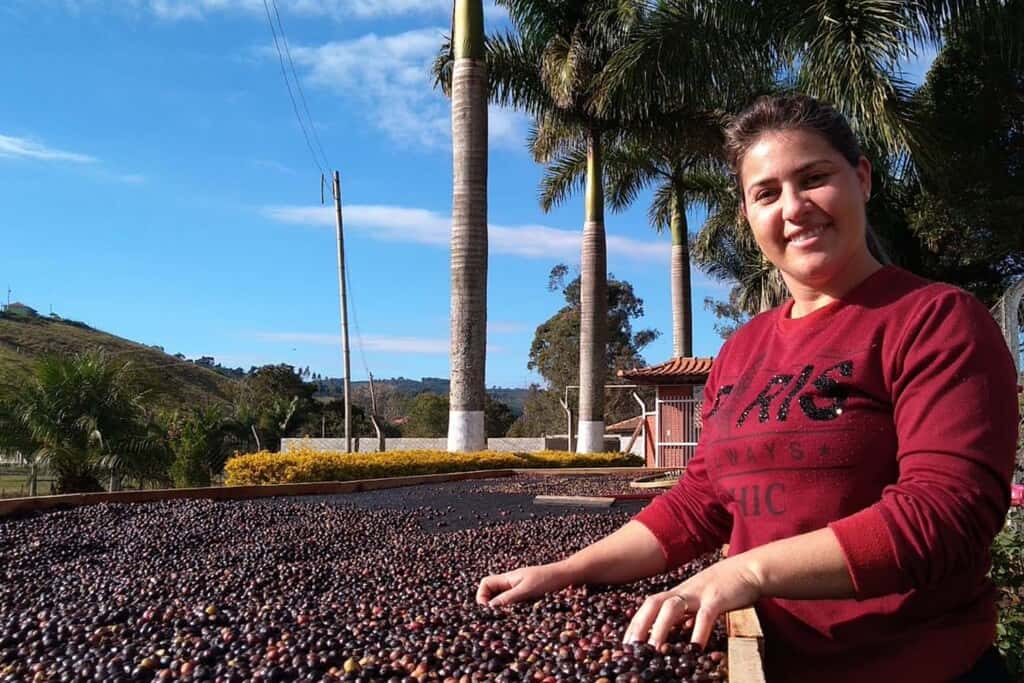
Natural process coffee drying on a raised bed at Sitio Taquara farm, Campestre, Minas Gerais State, Brazil. Pictured with Edimara Bernardes, the daughter of the producer. Courtesy of Demilson Batista Jr.
Two of the eight reviewed Brazils were not naturals at all, strictly speaking, but processed by the method Brazilians call pulped natural, a procedure that the rest of the world has come to know as honey-processing. Brazilians pioneered the method, although their rather technical name for it has stayed at home. In the Brazil version, only the skins are removed from the coffee fruit, and the beans, still covered in their sticky fruit flesh, are put out to dry directly on patios. They need to be raked rigorously at first, or the beans are likely to clump and mold. Done right, Brazil pulped naturals typically produce a sort of natural-lite cup; more delicate than most naturals, a bit brighter and lighter, more floral. The result can be a svelte, balanced Brail cup, clean and quietly layered, like the Willoughby’s Brazil Legender Sitio Taquara Natural (92). But the method also can encourage more distinctive profiles, like the Mostra Coffee Sitio Pedra Menina (93), here gently tart and fragrant with floral and herb nuance.
And a Last No-Frills Natural
Finally, we did have one straightforward Brazil-style natural among the eight top-rated samples — in other words, a coffee dried in the whole fruit straight through without any ferment step or processing variations. The simplicity of means seems reflected in the pleasing directness and grace of the Brazil Natural Veloso Estate from Taiwanese roaster Min Enjoy Café (93). “A quietly transcendent Brazil natural cup, harmonious and integrated,” co-cupper Kim Westerman writes.
Tree Variety and Brazil
Tree variety, along with processing method the other main driver of change and excitement in specialty coffee today, did not seem to figure prominently among the Brazils we surveyed. Brazil has tended to stick with tree varieties that are productive and respected for their cup character but not particularly celebrated for their distinctiveness. So, on one hand, no extravagant Geishas or other exotic Ethiopia escapees, but, on the other, no varieties heavily dumbed down with Robusta genes either. The variety most frequently appearing among this month’s samples is Catuaí, a cross between Caturra (the widely-grown, compact-growing selection of Bourbon) and Mondo Novo, itself a cross between Typica and Red Bourbon. My experience suggests Catuaí can be depended upon to produce a complete, lively, well-structured cup, though usually not a particularly distinctive one.
The Brazil “Aha” Moment
So, ok, Brazils may not rattle your saucers with shock and aromatic excitement, but they do have their supporters among those roasters who submitted this month. Several cited a specific “aha” Brazil moment, a Brazil coffee that challenged expectation. David Hsiao at Min Enjoy Café offers customers blind tastings, and when he included this month’s classic Brazil natural his customers were quite impressed. “Someone guessed it was Colombia, someone said Panama, someone guessed Costa Rica,” he reports. “When the hole card was revealed, every customer showed a surprised expression and said, ‘Is this really coffee from Brazil?’ They couldn’t believe it was so delicious!” Other roasters offered similar stories about specific coffees that challenged customers’ expectations about Brazil.
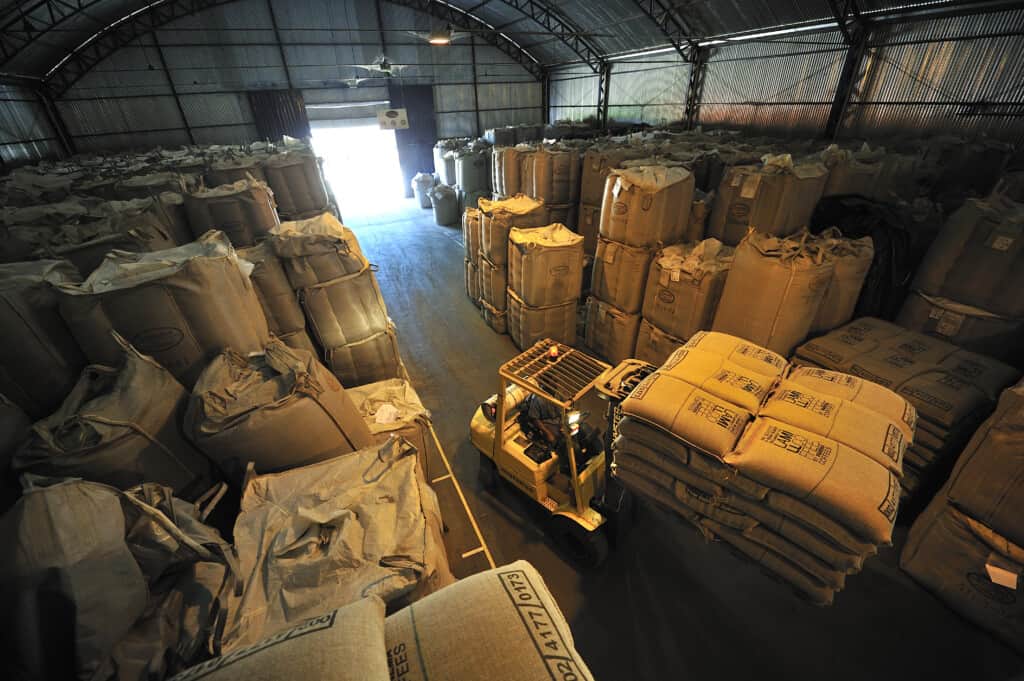
Warehouse of a coffee mill in Alfenas, Minas Gerais State, Brazil.
On the other hand, some roasters expressed appreciation for the very reliability of Brazils, for their familiarity and their capacity to satisfy a wide range of tastes. David Pittman of Peach Coffee Roasters sees Brazils as a “gateway to the non-specialty coffee drinker,” and adds that “this is the customer we at Peach are trying to reach.” Ryan Sullivan of Mostra Coffee describes the importance of Brazils in first establishing his roasting company in a geography new to specialty coffee, and how important Brazils have remained. “Brazil is always in the top five best-selling coffees and, as a single-origin, Brazil is our top-selling coffee over the course of the year. We would be a different company without Brazil to offer, and I don’t think our clientele would be too happy with us!”
Familiar Yet Fresh
Finally, the appeal for me of many of this month’s top-rated Brazils, particularly those I am calling “enhanced naturals,” is the way that they both support yet transcend our expectations. In drinking them, we may enjoy many of the satisfactions of a fine Brazil natural — the balance, the coherence, the fine mouthfeel, the rounded acidity and quietly complete range of aromatics (and yes, the cocoa and nut) — but along with that, we may find, owing to the care of the producer and thoughtful processing variation, a certain edge of originality, some twist or nuance capable of breaking through our work or reverie, reminding us that we are drinking a specific coffee, at a specific moment — and at that moment, something special, however transitory, is passing between us and the cup.
Special Thanks
To Caesar Tu, David Pittman, David Hsiao, May Wang, and Ryan Sullivan for contributing immeasurably to this report by sharing their attitudes and their customers’ attitudes toward Brazil coffees.
The post Brazil Naturals: Tradition and Innovation appeared first on Coffee Review.
